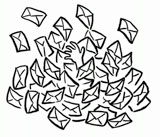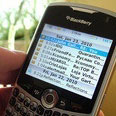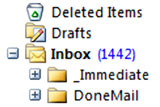|
|
|
Inbox Overload! (How to get your message delivered to very busy people)
There are two kinds of people in the business world: those with tidy inboxes who always stay on top of all their messages, and those with overflowing inboxes containing hundreds or sometimes thousands of unread messages. The latter group are not all hyper-busy company owners, investors, or high-profile "industry celebrities," and -- of course -- the former are not all anal-retentive "detail people" with "no life." However, allow me to generalize about the full inbox crowd: they are often the people you need to reach the most. They're the busy entrepreneurs, the money people, and the centers of influence. I'm going to refer to them as EO's (for Email Overloads) in this article. Please understand that EO's don't enjoy having an out-of-control inbox, rather it happens because they receive a ton of unsolicited mail every day. I'm not talking about spam -- which has been greatly minimized via filters -- rather, I mean the hundreds of daily inbound "one-off" emails, most from people they don't know or only vaguely remember. What if you are one of those unknown or dimly remembered people and you need to reach an EO to book an appointment, get a referral/introduction, get funding for your project, a donation for your charity, or any other important "ask?" What can you do to increase the chance that your message will be read and acted upon? Plenty. These 5 tips will help: 1. Compose Your Subject Line with Care
The subject line is critical. Compose it with the same amount of care you put into the body of your message. Make it long and detailed. Flag it with the person's name. (If you're not on first name basis, as is likely the case, prefix your subject with "Attn: John Jones..." Remember that the open/delete decision is almost always made based upon the subject line, especially if the EO doesn't recognize the sender, which leads to Tip #2.
3. Personalize the Salutation 4. You Only Have a Few Sentences -- Make them Count. (a) Provide context or a reference's name immediately. If you met at a function, even if you had a conversation, don't assume the EO remembers you or anything you talked about. If this is a cold (or semi-cold) approach and you can drop the name of a mutual contact, so much the better. (b) Keep to a single topic (the one you referenced in the subject line). If you have multiple different things to relate or request, compose multiple messages. (c) Broadcast on the WIIFM channel. Make sure to state your request in a way the EO can immediately grasp "What's in it for me." (Not all correspondence lends itself to this, but it's always worthwhile to think it while composing your message.) (d) Be explicit. This is not the time to be subtle or drop hints. You're likely writing because you want or need something: a meeting/appointment, a door opened for you, a referral, some money, etc. Out with it! (e) Make it easy to reply to you. Your close should contain a question, one that can be answered immediately. Otherwise you run the risk that your message will get shunted to the "I'll get to this later" pile. (Alas, for an EO, in this context, later often equates to never). You can also avoid this fate by having full contact information in your signature. These days, it's common and totally OK to have a sig with detailed information and relevant links (for example, to your LinkedIn profile).
5. Do Not Expect a Reply Now that you know about this common mass-deletion strategy, you should change your thinking. Don't take a non-response personally and don't assume that no reply means no interest. Resend your message or pick up the phone. Just don't call and ask, "Did you get my email?" EO's hate that. I'm going to conclude this article by once again ranting about the double-edged sword that email has become. For such an important business communication tool, and one we've become so dependent upon, email is based on fundamentally flawed technology. Even though it's convenient for the sender and the preferred communication mode of many EO's, email is an "open loop." Fortunately, the old stuff still works too. I checked and your phone still has a dial tone. Also, good old-fashioned postal mail still gets delivered by a uniformed government employee for only 44 cents... |


 2. Send Emails from a Recognizable (Preferably Company) Account
2. Send Emails from a Recognizable (Preferably Company) Account
 Nor should you assume your email was ever looked at or even received. Remember, your EO likely receives hundreds of "important" emails a day. While most EO's try to get through them (after all, happiness IS an empty inbox), it doesn't take much to waylay those plans. They'll get caught up with a project or urgent matter and before not too long, there are a thousand+ unread emails in there. When confronted with the daunting prospect of slogging through all those messages, what do most EO's do? That's right, they delete them all and start over! I asked someone who does this on a regular basis if she was concerned about deleting something important and she replied, "How important could it be? If it's truly critical, they'll email again or more likely just call me." (This approach reminds me of the Vietnam-era soldier's motto of "Kill 'em all and let God sort 'em out.")
Nor should you assume your email was ever looked at or even received. Remember, your EO likely receives hundreds of "important" emails a day. While most EO's try to get through them (after all, happiness IS an empty inbox), it doesn't take much to waylay those plans. They'll get caught up with a project or urgent matter and before not too long, there are a thousand+ unread emails in there. When confronted with the daunting prospect of slogging through all those messages, what do most EO's do? That's right, they delete them all and start over! I asked someone who does this on a regular basis if she was concerned about deleting something important and she replied, "How important could it be? If it's truly critical, they'll email again or more likely just call me." (This approach reminds me of the Vietnam-era soldier's motto of "Kill 'em all and let God sort 'em out.")